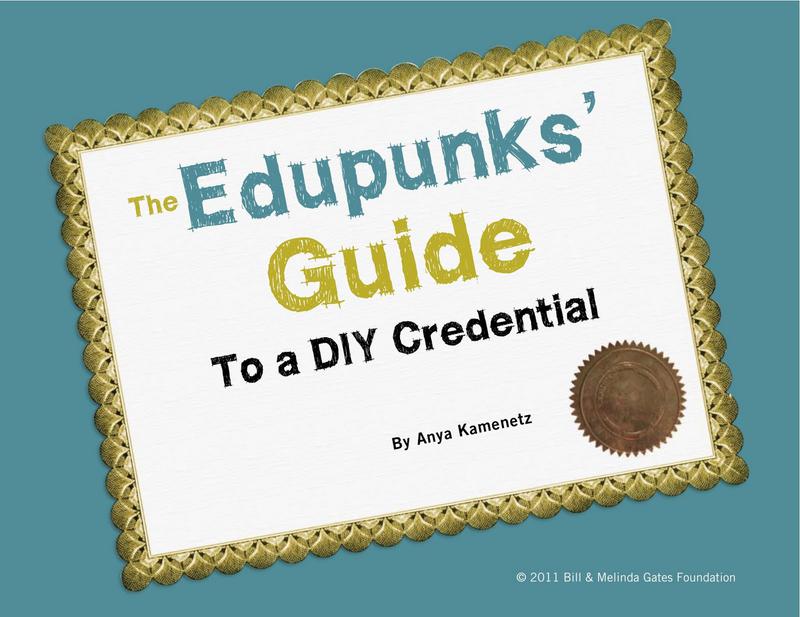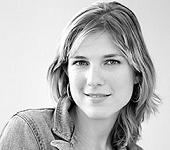This how-to is an excerpt from Anya Kamentz’s ebook The Edupunks’ Guide To a DIY Credential. To find out more and get your free copy, click here.
There are plenty of open resources on the Internet to allow for college-level learning on almost any topic. But diving in can be daunting.
If you want to read a textbook, answer the questions at the end of each chapter, and take a sample test, you can certainly simulate that kind of traditional classroom-based learning online, but there are many, many other possibilities.
Just as the three main “buckets” of traditional education are Content, Socialization, and Accreditation, or the “what,” the “how,” and the “why,” the world of open learning can be divided roughly into the parallel buckets of open content, social learning, and reputation-based networks.
Open content is the “what.” Content means textbooks, video and audio lectures, lessons, problem sets, and sample tests and quizzes. The most common form of open content that you have probably turned to for a quick definition or overview of a topic is Wikipedia. Open content, or open educational resources, are found on websites like MIT’s Open Courseware, The Open Courseware Consortium, the Open Learning Initiative, Khan Academy, Open Yale Courses, iTunes U, Academic Earth, Saylor.org, Scribd, Slideshare, Textbookrevolution, Wikiversity, and many more. In a bricks-and-mortar university, Open Content is the equivalent of the lecture hall and the library.
Open social learning happens on sites like P2PU, OpenLearn, OpenStudy, Wikianswers, Quora, Urch, and even Twitter. These are places where you can ask or answer a complex technical question, form or join a book group, or get help studying for the SATs. These sites can be the equivalent of the pizza and study group, the tutoring center, or the seminar.
Reputation-based networks are places like Behance, Github, StackOverflow, Flickr, Vimeo, and maybe even LinkedIn and again, Twitter. These are places where you can post your work, get recognized for a project or for your knowledge. Think of these networks as your career services office.
While you’re taking part in open learning communities you’ll quickly find that it pays to be a good citizen who shares, answers questions, and helps others out—it will come back to you.
Open education also means that use of these resources is at your own risk. None of these “colleges” or “universities” is accredited yet, which means you can’t earn a bona fide degree here. But participation in open learning communities and networks is an incredible way to improve your learning experience, and to demonstrate value to a professional community, which will eventually help you find a job. In some special cases, it may even supplant the need for a degree.
To give you an idea of what’s possible today in the open world, meet Joseph Frantz. When I met Joseph he was a 20-year-old junior at CSU San Bernadino, a public university in the windy foothills of the Sierras east of Los Angeles. He left high school at 16 and, in his words, “fucked around” in community college for a couple of years. He worked as a personal trainer and in a guitar store, jobs he “hated,” which sent him back to college. His budget allowed only for a public university, which he found pretty disappointing. “This is what you do?” he says he thought when he got to CSUSB. “This is it? The whole thing? It’s a joke, it’s a racket.”
In the past a bright, rebellious student like Joseph might have gotten bored and quit college for good. But Joseph had glimpsed another way. “I lived in Boston for a year with some guys who went to MIT. They just loved learning things. They would watch the TED Talks and Open Courseware videos in our little dining room. When I came back here to school I realized, the lectures I’m attending are the same topics they give at MIT, and if I watch them online I can watch them whenever I want. Then one day, I was searching Youtube to clarify some math concepts and I found Khan Academy. I thought, this is so much easier! And I stopped going to class.”
Today Joseph is earning straight A’s as an economics major at CSUSB. In his free time he writes fiction and reads authors like Michael Chabon and Jonathan Lethem. He tutors other students in economics, but rarely goes to class himself, preferring to teach himself with free videos, reading, and problem sets online. The main sites he likes to use are MIT’s Open Courseware, which is organized in full courses with 50-minute videos, problem sets, and sample exams, and Khan Academy, which features much shorter, 5 to 10 minute tutorials. “That guy Sal Khan, he’s like my hero. He’s so funny. He has this comedic timing even when he’s talking about math.” Joseph developed his self-teaching methods over time, through trial and error. He finds them a lot more efficient and even fun than waiting to learn at the pace of a course. “I go from the MIT to the Khan. Khan reinforces MIT. MIT presupposes that you have all this knowledge, and Khan doesn’t. Sometimes I go back to the textbook and if it’s really something I can’t understand I go to the tutoring center or professors’ office hours. Between all that it makes it really easy to learn things. I tutor Math and Econ at the learning center and I tell students to go watch the Khan videos when they don’t have a solid background in something.”
He also checks definitions on Wikipedia, searches and posts questions and answers on Urch.com, a forums site that has a message board for PhD students in economics, and finds free textbooks to download on TextbookRevolution.org.
“At least for me, learning has to be question-based,” he tells me. “I found that the biggest challenge to learning online is knowing the questions to ask. For me, finding the right question often meant working backwards. When you’re teaching yourself, you have to work off basic assumptions, against which you can relate back pieces of information. These assumptions function as a path towards the questions that necessary to facilitate understanding. Two common ones that I use are: Every significant piece of information is part of one or more theories and every theory can be broken into smaller modular components. Every theory uses a set of symbols, not all of which are language-based. When first presented with a concept now, my initial reaction is to find where it fits into established systems of thought or understanding. Once the concept is placed, I ask myself what its components are, and learn them on the fly as I try to make applications in the real world. I often have the aid of textbooks giving me example problems as a way for me to test the know- ledge I’ve acquired. The next question is the symbols. Math, for example, uses Greek letters, and an entire set of operators generated by mathematicians over hundreds of years. Economics uses graphs, mathematical operators, and spoken English. In a chemistry lab, we use models; these symbols in the physical world reinforce theories that are explained by English and math on paper.”
An easy way to begin an online learning journey, he tells me, is to simply listen for words you don’t understand. “In class a word is usually linked to a concept—say Eigenvector, or Bayesian analysis. Google it and it might lead to a Wikipedia entry, and then you get the basic framework of what this is. Then go over to Khan Academy and have him illuminate it more clearly until you get it.”
Here’s a method, distilled from the stories of many different edupunks I talked to.
1. Start with a question. “What does the Federal Reserve do, anyway?” “How does a wind turbine work?” You may turn first to video sites like YouTube or TED for an overview.
2. Zero in on unfamiliar words, phrases, symbols or expressions. “Bayesian analysis,” “Fourier transform”—Wikipedia, Scholarpedia or Wikiversity might be good places to start, but you’ll want to follow the links from there to source materials, papers, textbooks, book excerpts on Google, and others.
3. Do some serious reading. You may have several tabs open at this point. This phase can last hours or days. You may also want to try sample problems or exercises.
4. Ask someone a question. You may want to locate some experts on the topic, through Slideshare, Youtube, blogs, Twitter, or more. Or you can search forums or other online learning communities for help.
5. Test and demonstrate your knowledge. MIT Open Courseware, Khan Academy, and other sites may have sample problems. Or you can go onto a forum and answer someone else’s question. Or blog about your discoveries!









